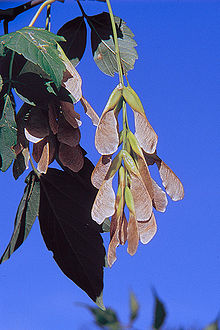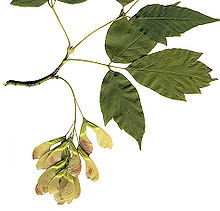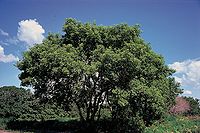- Acer negundo
-
"Box elder" redirects here. For the box elder bug, see Boisea trivittata. For other uses, see Box Elder (disambiguation).
Acer negundo 
Conservation status Scientific classification Kingdom: Plantae (unranked): Angiosperms (unranked): Eudicots (unranked): Rosids Order: Sapindales Family: Sapindaceae[2] Genus: Acer Species: A. negundo Binomial name Acer negundo
Carolus Linnaeus
Range Acer negundo is a species of maple native to North America. Box Elder, Boxelder Maple, and Maple Ash are its most common names in the United States. Other variant names, some of which are regional, include: Ash Maple, Ash-leaf Maple, Black Ash, California Boxelder, Cutleaf Maple, Cut-leaved Maple, Negundo Maple, Red River Maple, Stinking Ash, Sugar Ash, Three-leaved Maple, and Western Boxelder. In Canada it is commonly known as Manitoba Maple and occasionally as Elf Maple.[3] In Russia it is called American Maple (Russian: американский клён) as well as Ash-leaf Maple (Russian: клён ясенелистный).
Contents
Description
Acer negundo is a small, usually fast-growing and fairly short-lived tree that grows up to 10–25 metres (33–82 ft) tall, with a trunk diameter of 30–50 centimetres (12–20 in), rarely up to 1 metre (3.3 ft) diameter. It often has several trunks and can form impenetrable thickets.[4]
The shoots are green, often with a whitish to pink or violet waxy coating when young. Branches are smooth, somewhat brittle, and tend to retain a fresh green colour rather than forming a bark of dead, protective tissue. The bark on its trunks is pale gray or light brown, deeply cleft into broad ridges, and scaly.[5]
Unlike most other maples (which usually have simple, palmately lobed leaves), Acer negundo has pinnately compound leaves that usually have three to seven leaflets. Simple leaves are also occasionally present; technically, these are single-leaflet compound leaves. Although some other maples (such as A. griseum, Acer mandshuricum and the closely related A. cissifolium) have trifoliate leaves, only A. negundo regularly displays more than three leaflets.
The leaflets are about 5–10 centimetres (2.0–3.9 in) long and 3–7 centimetres (1.2–2.8 in) wide with slightly serrate margins. Leafs have a translucent light green colour and turn yellow in the fall.
The flowers are small and appear in early spring on drooping racemes 10–20 centimetres (3.9–7.9 in) long. The seeds are paired samaras, each seed slender, 1–2 centimetres (0.39–0.79 in) long, with a 2–3 centimetres (0.79–1.2 in) incurved wing; they drop in autumn or they may persist through winter. Seeds are usually both prolific and fertile.
Unlike most other maples, A. negundo is fully dioecious and both a "male" and "female" tree are needed for either to reproduce.
- Winter buds: Terminal buds acute, an eighth of an inch long. Lateral buds obtuse. The inner scales enlarge when spring growth begins and often become an inch long before they fall.
- Flowers: April, before the leaves, yellow green; staminate flowers in clusters on slender hairy pedicels one and a half to two inches long. Pistillate flowers in narrow drooping racemes.
- Calyx: Yellow green; staminate flowers campanulate, five-lobed, hairy. Pistillate flowers smaller, five-parted; disk rudimentary.
- Corolla: Wanting.
- Stamens: Four to six, exserted; filaments slender, hairy; anthers linear, connective pointed.
- Pistil: Ovary hairy, borne on disk, partly enclosed by calyx, two-celled, wing-margined. Styles separate at base into two stigmatic lobes.
- Fruit: Maple keys, full size in early summer. Borne in drooping racemes, pedicels one to two inches long. Key an inch and a half to two inches long, nutlets diverging, wings straight or incurved. September. Seed half an inch long. Cotyledons, thin, narrow.[5]
Taxonomy and naming
Indicative of its familiarity to many people over a large geographic range, A. negundo has numerous common names.
The names "Box Elder" and "Boxelder Maple" are based upon the similarity of its whitish wood to that of boxwood and the similarity of its pinnately compound leaves with those of some species of elder.[6] This is the only North American maple with compound leaves.[5]
Other common names are based upon this maple's similarity to ash, its preferred environment, its sugary sap, a description of its leaves, its binomial name, and so on. These names include (but are not limited to) Ash-, Cut-, or Three-leaf (or -leaved) Maple; Ash Maple; Sugar Ash; Negundo Maple; and River Maple.[7]
Common names may also designate a particular subspecies. For example, a common name for A. negundo subsp. interius may be preceded by "Inland" (as in "Inland Boxelder Maple"). A common name for A. negundo subsp. californicum may be preceded by "California" or "Western".
Subspecies
Acer negundo is often discussed as comprising three subspecies, each of which was originally described as a separate species. These are:
- A. negundo subsp. negundo is the main variety and the type to which characteristics described in the article most universally apply. Its natural range is from the Atlantic Coast to the Rocky Mountains.[4]
- A. negundo subsp. interius has more leaf serration than the main species and a more matte leaf surface. As the name interus indicates, its natural range of Saskatchewan to New Mexico is sandwiched between that of the other two subspecies.[4]
- A. negundo subsp. californicum has larger leaves than the main species. Leaves also have a velvety texture which is essential to distinguish it from A. negundo subsp. negundo. It is found in parts of California and Arizona.[4]
Some authors further subdivide subsp. negundo into a number of regional varieties but these intergrade and their maintenance as distinct taxa is disputed by many. Even the differences between recognized subspecies are probably a matter of gradient speciation
Finally, note that a few botanists treat Boxelder Maple as its own distinct genus (Negundo aceroides) but this is not widely accepted.
Distribution
As noted, varieties thrive across the United States and Canada. It may also be found as far south as Guatemala
Ecology
This species prefers bright sunlight. It often grows on flood plains and other disturbed areas with ample water supply, such as riparian habitats. Human influence has greatly favoured this species; it grows around houses and in hedges, as well as on disturbed ground and vacant lots.
Several birds and some squirrels feed on the seeds. The Evening Grosbeak uses them extensively. The Maple Bug (also known as the Boxelder Bug) lays its eggs on all maples, but prefers this species.
Cultivation
Although its weak wood, irregular form, and prolific seeding might make it seem like a poor choice for a landscape tree, A. negundo is one of the most common maples in cultivation and many interesting cultivars have been developed, including:[4]
- 'Auratum' - yellowish leaves with smooth undersides
- 'Aureomarginatum' - creamy yellow leaf margins
- 'Baron' - Hardier & seedless variety
- 'Elegans' - distinctively convex leaves
- 'Flamingo' - pink and white variegation (very popular)
- 'Pendulum' - with weeping branches.
- 'Variegatum' - creamy white leaf margins
- 'Violaceum' - younger shoots and branches have bluish colour
Although native to North America, it is considered an invasive species in some areas of that continent. It can quickly colonize both cultivated and uncultivated areas and it has become naturalized in eastern China.[4] The range is therefore expanding both in North America and elsewhere. It can also be found in some of the cooler areas of the Australian continent where it is listed as a pest invasive species.
Although its light, close-grained, soft wood is considered undesirable for most uses, this tree has been considered as a commercial source of wood fiber, for use in fiberboard.
There is some commercial use of the tree for various decorative applications, such as turned items (bowls, stem-ware, pens). Primarily burl wood and injured wood, where the primary reason is this wood's reaction to injury, where the injured wood develops a red stain.
Archaeological Artifacts
Acer negundo was identified in 1959 as the material used in the oldest extant flutes from the Americas that were made of wood. These early artifacts, excavated by Earl H. Morris in 1931 in the Prayer Rock district of present-day NorthEastern Arizona, have been dated to 620-670 CE[8].
The style of these flutes, now known as Anasazi flutes, uses an open tube and a splitting edge at one end. This design pre-dates the earliest known Native American Flute (which use a two-chambered design) by 1,200 years.
Notes
- ^ "Acer negundo". NatureServe Explorer. http://www.natureserve.org/explorer/servlet/NatureServe?searchName=Acer+negundo. Retrieved 2007-07-03.
- ^ Stevens, P. F. (2001 onwards). Angiosperm Phylogeny Website. Version 9, June 2008 [and more or less continuously updated since]. http://www.mobot.org/MOBOT/research/APweb/.
- ^ Community trees of the Prairie provinces - Canadian Forest Service
- ^ a b c d e f van Gelderen, C.J. & van Gelderen, D.M. (1999). Maples for Gardens: A Color Encyclopedia.
- ^ a b c Keeler, H. L. (1900). Our Native Trees and How to Identify Them. New York: Charles Scriber's Sons. pp. 85–87.
- ^ DePauw University
- ^ Acer spp. Aceraceae Note that some of the common names given in this reference are questionable. "Stinking Ash" and "Black Ash" typically refer to Ptelea trifoliata and Fraxinus nigra, respectively. This reference is retained as an example of the confusion which arises when plants such as A. negundo are discussed by other than their scientific names.
- ^ Clint Goss (2011). "Anasazi Flutes from the Broken Flute Cave". http://Flutopedia.com/brokenflutecave.htm. Retrieved 20110-10-18.
Bibliography
- Philips, Roger. Trees of North America and Europe, Random House, Inc., New York ISBN 0-394-50259-0, 1979.
- Maeglin, Robert R.; Lewis F. Ohmann (1973). "Boxelder (Acer negundo): A Review and Commentary". Bulletin of the Torrey Botanical Club 100 (6): 357–363. doi:10.2307/2484104. JSTOR 2484104.
External links
- Profile: Manitoba Maple (Acer negundo) Photos, Drawings, Text. (Wild Plants of Winnipeg from Nature Manitoba)
- Acer negundo Winter ID pictures
- Acer negundo images at bioimages.vanderbilt.edu
- Acer negundo facts and diagnostic traits
- Interactive Distribution Map of Acer negundo
Categories:- NatureServe Secure species
- Acer
- Invasive plant species
- Trees of humid continental climate
- Ornamental trees
- Trees of Ontario
- Trees of Alberta
- Trees of Manitoba
- Trees of Saskatchewan
- Trees of Alabama
- Trees of Connecticut
- Trees of Indiana
- Flora of Massachusetts
- Trees of Michigan
- Trees of New Hampshire
- Trees of New Jersey
- Trees of New York
- Trees of Ohio
- Trees of Pennsylvania
- Trees of Vermont
- Trees of West Virginia
- Trees of Illinois
- Trees of Iowa
- Trees of Kansas
- Trees of Minnesota
- Trees of Missouri
- Trees of Nebraska
- Flora of North Dakota
- Trees of Oklahoma
- Trees of South Dakota
- Trees of Wisconsin
- Trees of Colorado
- Trees of Montana
- Trees of Wyoming
- Trees of Arkansas
- Trees of Delaware
- Trees of Florida
- Trees of Georgia (U.S. state)
- Trees of Kentucky
- Trees of Louisiana
- Trees of Maryland
- Trees of Mississippi
- Trees of North Carolina
- Trees of South Carolina
- Trees of Tennessee
- Trees of Virginia
- Trees of New Mexico
- Trees of Texas
- Trees of Arizona
- Trees of California
- Trees of Utah
- Trees of Mexico
- Trees of Guatemala
Wikimedia Foundation. 2010.



